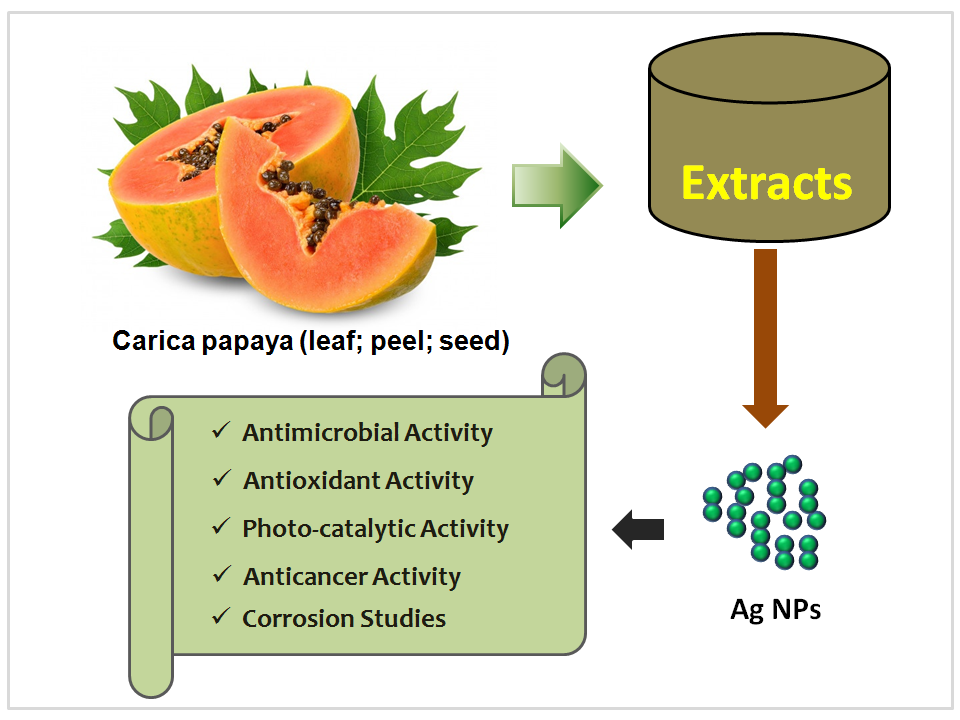Chemical Science & Engineering Research
Title
Synthesis of Carica Papaya (Leaf, Peel and Seed) Extracts Mediated Ag Nanoparticles for Industrial and Medical Applications
Authors
Supraja N.,*a Kishore B.,b Rajasekhar K.K.c and Padmavathamma M.d
aNanotechnology Laboratory, Institute of Frontier Technology, Regional Agricultural Research Station, Acharya N G Ranga Agricultural University, Tirupati-517 502, AP, India.
bDepartment of Pharmaceuticals, Tirupati-517502.
cDepartment of Pharmaceutical Chemistry, Sri Padmavathi School of Pharmacy, Tirupathi-517503, Andhra Pradesh, India.
dSenior lecturer in Pharmacy, SVMP Womens Polytechnic College, Tirupati.
*Corresponding author E-mail address: krishna.supraja@gmail.com (Supraja N.)
Article History
Publication details: Received: 10th September 2020; Revised: 12th October 2020; Accepted: 12th October 2020; Published: 07th November 2020
Cite this article
Supraja N.; Kishore B.; Rajasekhar K.K.; Padmavathamma M. Synthesis of Carica Papaya (Leaf, Peel and Seed) Extracts Mediated Ag Nanoparticles for Industrial and Medical Applications. Chem. Sci. Eng. Res., 2020, 2(5), 29-39.

Abstract
Synthesis of metal nanoparticles using biological systems is an expanding research area in nanotechnology. Moreover, search for new nanoscale antimicrobial is been always attractive as they find numerous avenues for application in medicine. Bio synthesis of metallic nanoparticles is cost effective and eco-friendly compared to those of conventional methods of nanoparticles synthesis. Herein, we reported a green and simple method for bio synthesizing silver nanoparticles (AgNPs) using Carica papaya leaf, peel and seed extracts as reducing and stabilizing agent. FTIR, XRD, UV–VIS spectroscopy, and DLS have been used for characterizing the bio synthesized AgNPs. The results indicating the AgNPs synthesized by Carica papaya leaf, peel and seed extracts have high purity and the average size is 90 nm. The antioxidant property was studied by radical scavenging (DPPH) assay, antimicrobial activity of AgNPs was evaluated (in vitro) against fungi, Gram-negative, and Gram-positive bacteria using disk diffusion method. Anti-corrosion studies were carried out using coupon method (mild steel) and photo-catalytic activity of the AgNPs has been investigated by degradation methylene blue under visible light irradiation. Due to the smaller size, the biosynthesized AgNPs showed an excellent photo-catalytic (Dye degradation) performance. The synthesized AgNPs exhibited effective anti-cancerous activity (at doses 1 and 40μg/ml of AgNPs) against Chinese hamster ovary cancer cell lines.
Keywords
Carica papaya leaf; peel; seed extracts; Antimicrobial activity; Antioxidant activity; photo-catalytic activity; Anti-cancerous activity; Corrosion studies